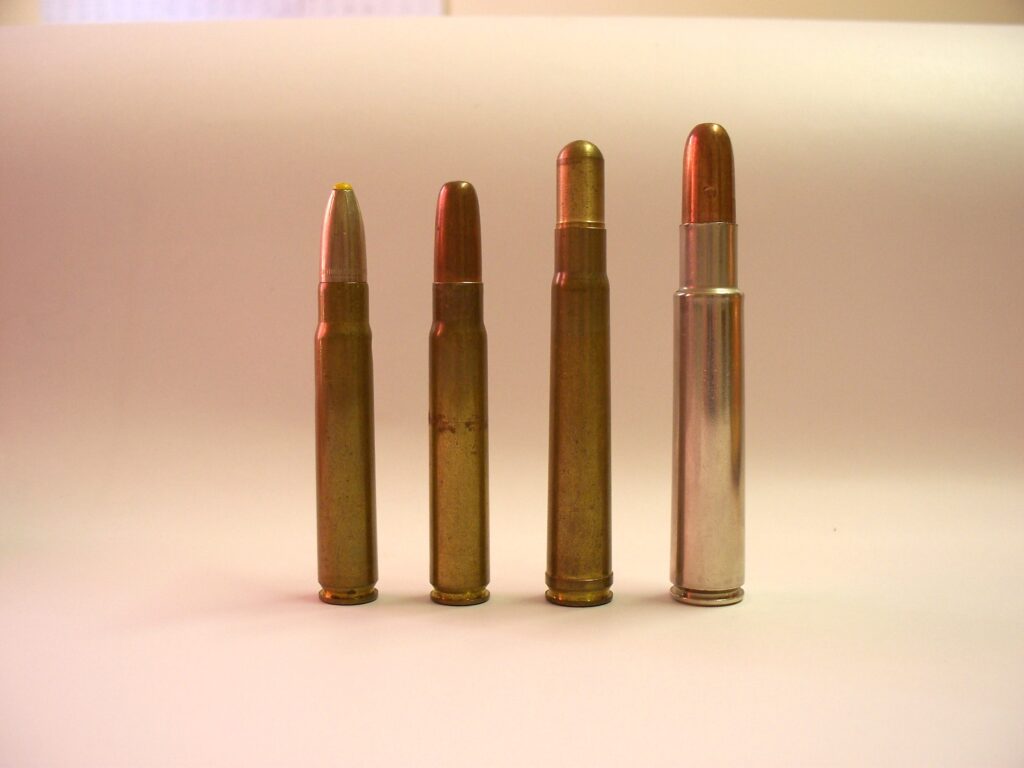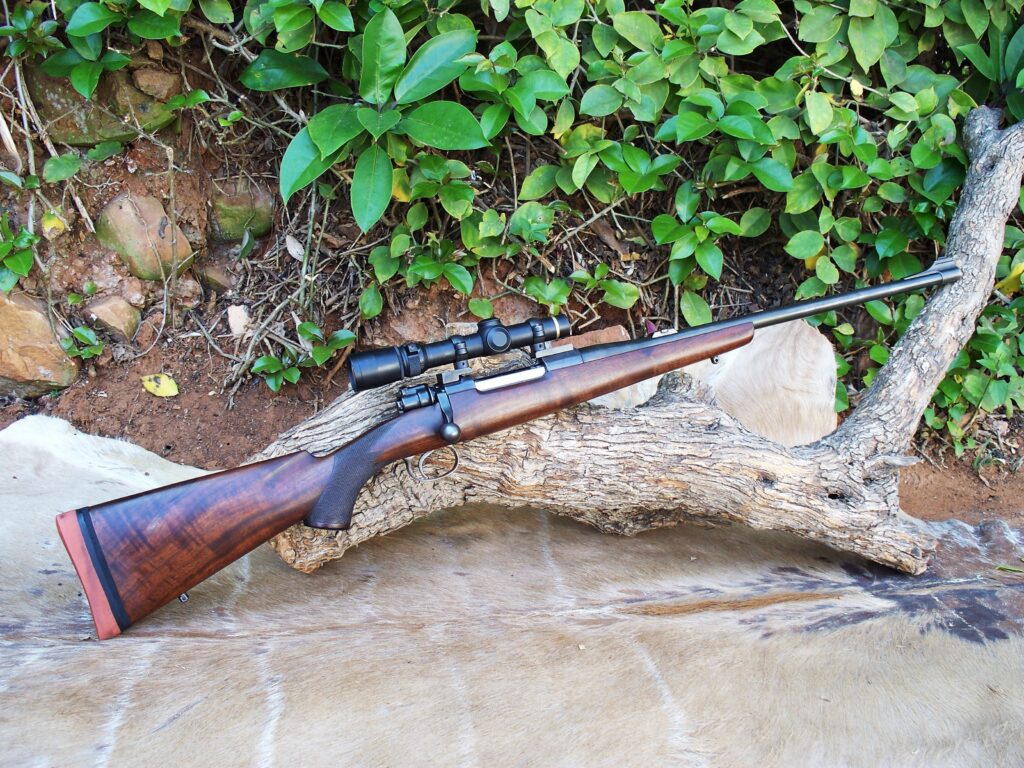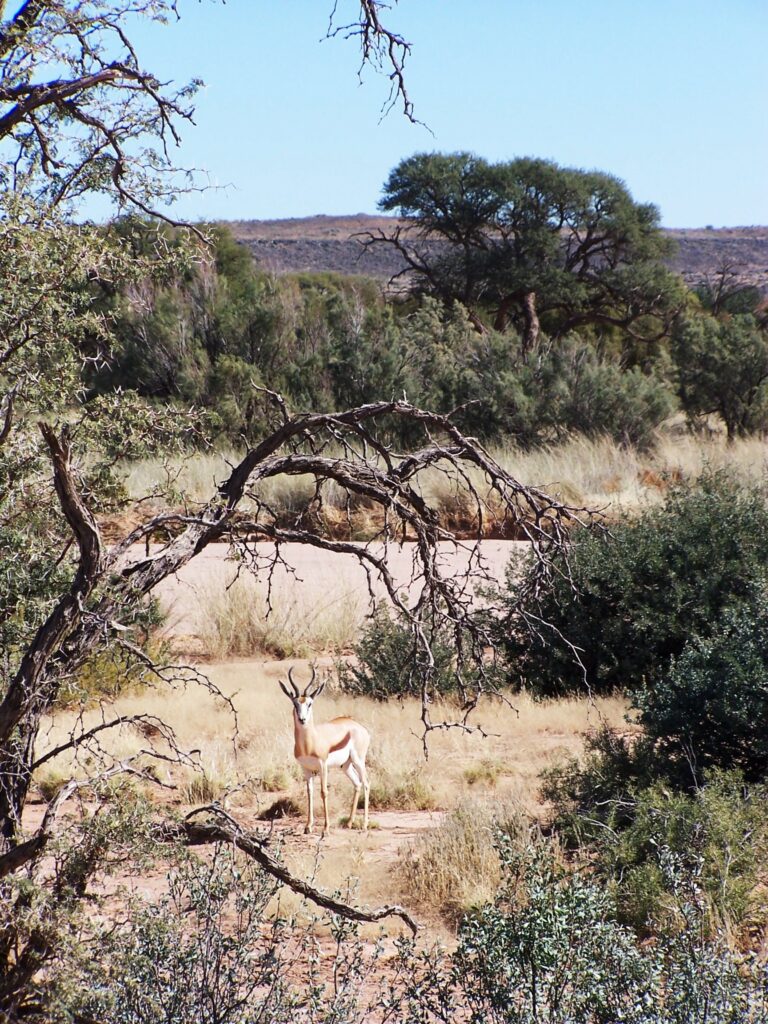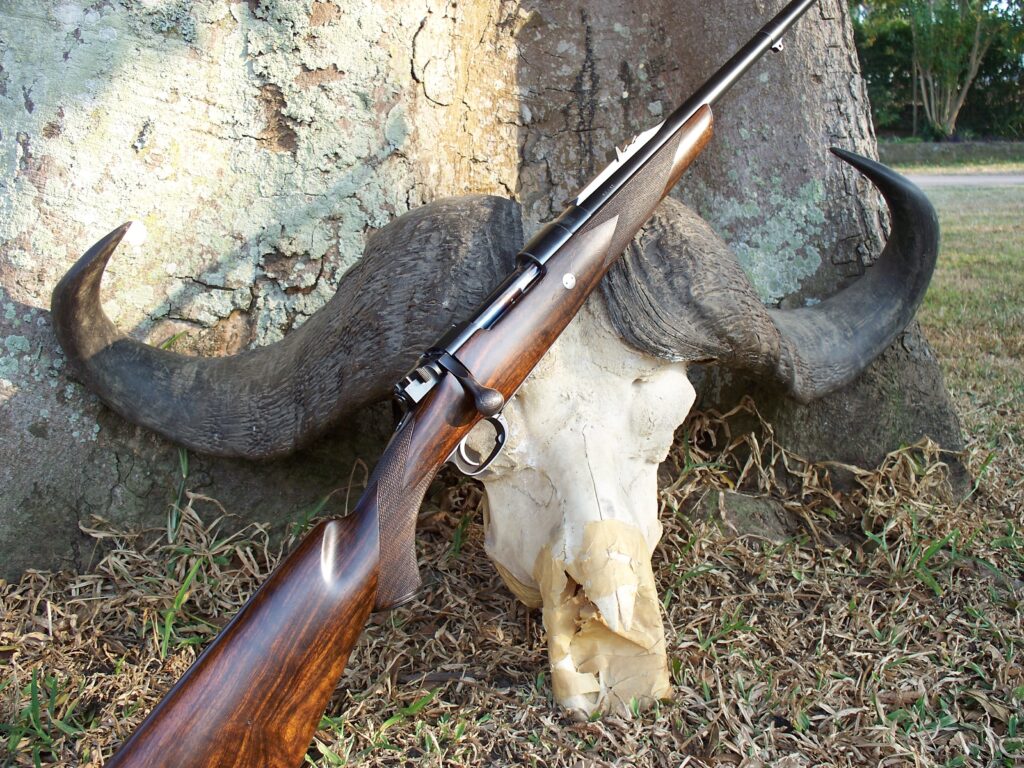The great 9.3×62 Mauser is recognised in Europe and Africa as one of the best big game calibres ever, yet it is virtually unknown in some hunting circles in the United States.

Although slightly less powerful than the other two, the 9.3 packs enough punch to qualify as a general-purpose cartridge for African game.
When it was introduced in the early 1900s, America already had the .405 Winchester which was similar in power to the 9.3, and America’s love affair with the lever-action probably blinded people to the merits of this European cartridge. The 9.3×62 has earned lasting fame in the Dark Continent as an all-rounder and once was the workhorse and darling of many British and European farmers in Africa. However, like some other very good cartridges of the day, the 9.3×62 almost faded into obscurity after World War II.
Designed by Otto Bock and introduced in 1905, the 9.3×62 was exactly what many farmers had been praying for. Africa was a hunter’s paradise but a farmer’s nightmare. Plantations and crops were continually destroyed by herbivores while the many carnivores, especially lions and leopards, tried their best to deplete the domestic livestock.

Life in Africa was hard, money tight and luxuries few and far between. Most hunters thus could only afford one or maybe two rifles. For general hunting, they wanted an affordable rifle in a powerful enough calibre to not only take care of large antelope, lions, and leopards but also buffalo and elephants. Bock’s cartridge was available in the high-quality yet affordable bolt-action Mauser which, due to Germany’s involvement in Africa, was readily available all over the continent.
The terrain in Namibia is varied. In some parts, shooting distances can be short while fairly long shots (up to 250m) are common in other parts.
Because of the bushveld terrain which dominates large expanses of land in Africa, lightweight, handy rifles with enough short-range killing power and the ability to take the odd moderately long-range shot at plains game, were preferred. Although the slightly more powerful .375H&H – introduced in 1912 – was also available, most Europeans farming in Africa chose Mausers in 9.3 because the .375H&H was a proprietary cartridge in those days and British rifles were more expensive than the high-quality Mausers.
Also, the .375 H&H’s reputation was marred by bullet failure because the softnose bullets of the day were not strong enough for the .375’s high velocity, especially at short, bushveld ranges.
World War II, however, almost abruptly ended the golden era of the 9.3×62.
The destruction of the Mauser factory at Oberndorf cut off the main supply of Mauser rifles while post-war political changes and restrictions did the same for other arms factories all over Europe. Ammunition manufacturing was stopped in Germany and even Kynoch in the UK started dropping the production of many “African” calibres until they eventually ceased all production in the 1960s. British rifles, especially custom rifles, were still very expensive so African hunters and farmers turned to America for affordable rifles chambered for so-called all-around cartridges.
Africa now also became the domain of the American hunter and as a result American cartridges flourished in the Dark Continent. Winchester brought out their Model 70, a rifle based on the Mauser design, and being unfamiliar with European metric cartridges, Americans opted for this high-quality and also affordable rifle chambered in .375H&H.
The Holland & Holland cartridge thus replaced the 9.3 as Africa’s all-purpose cartridge. The 9.3 was dealt another blow when many African countries introduced minimum-calibre legislation for dangerous game.
Although the 9.3 served with distinction, a minimum bullet diameter of .375″ was set and this unfortunate legislation relegated this great cartridge to the rank of a non-dangerous game cartridge. Make no mistake, the 9.3×62 is not the ideal elephant charge stopper but with the right bullets, it is any day as effective as the .375H&H on pachyderms.
Some African countries (Zimbabwe is one) do allow the use of 9.3s on dangerous game these days. The 9.3 is also legal for buffalo in some of South Africa’s provinces but not in KwaZulu-Natal where I live. In Namibia, it is legal for all plains game up to and including eland, as well as leopard and lion but not buffalo, elephant, hippo, rhino, or giraffe for which the minimum energy required at the muzzle is 3983ft/lbs. A 286-grain bullet leaving a 9.3’s muzzle at 2360fps produces 3540ft/lbs.
The 9.3×62 fits into standard-length actions and can therefore short, lightweight rifles can be built around this efficient cartridge.
When 9.3 ammunition became scarce many hunters had their rifles rebarrelled but faithful fans kept the cartridge alive because they realised that Otto Bock’s mild medium bore was all they needed for the African bush where shooting distances seldom exceed 150 to 200 yards. Another factor that African hunters like, is the minimal amount of meat damage this cartridge causes. Meat damage might not be a factor for trophy hunters but to meat hunters, it is very important.


The 9.3×62 launches a 286-grain bullet at 2360fps and when zeroed to print three inches high at 100 yards it is dead on at 200 and six inches low at 250 yards. Many Americans are obsessed with high velocity and long-range shooting but believe me, there is no need for magnums and true long-range shooting in Africa. Yes, you do get the odd long shot but even that should not be a problem because most hunters (and Professional hunters/guides) nowadays own rangefinders and once you know the distance to an animal, and of course the trajectory of your bullet/load combination, placing a bullet where it matters at 300 yards is not difficult.
Those who want to flatten the 9.3’s trajectory can switch to the various 250-grain bullets. Nosler’s excellent core-bonded Accubond comes to mind. Launched at 2550fps and zeroed at 200 yards it drops less than four inches at 250 and less than 10 inches at 300 yards. For any Plains game, even Cape Eland this bullet will do the job with accurate shot placement. There is a myth that African plains game animals are much tougher than American game, but that is nonsense. Yes, we have our tough customers such as buffalo, blue wildebeest, warthog, and gemsbuck, but no animal with a hole through its heart or lungs will ever get away. Hell, my favorite kudu, gemsbuck, and blue wildebeest rifle/calibre combination is a Remington in .30-06 stoked with 150-grain Nosler Accubonds or 130-grain GS Custom bullets (a South African manufactured monometal expanding bullet).
Faithful fans would not allow the 9.3×62 to die and it has been making a strong comeback in recent years. Today Norma, Sako, Highland, RWS, and PMP all produce factory ammunition while many more companies, including some from America, market 9.3 bullets as components, both in conventional and premium grade designs. Barnes and Woodleigh from Australia for instance, are known for the excellent solids they produce.
IMR4046 and IMR4320 seem to be the most suitable American powders for the 9.3×62. With these, it is possible to load 250-grain bullets to almost 2600fps while 2400fps is possible with 286-grainers. Speer markets a 270-grain bullet and Woodleigh produces a 320-grainer.
Points in favour of the 9.3 are its manageable recoil, the fact that it fits in standard-length actions, and that it is easy to form 9.3 cases from .30-06 brass. (Prime .30-06 cases, load them with 9-grain Unique followed by an over powder wad of cotton wool or toilet paper and uncooked rice – filled to the shoulder – and another wad. Fire this “blank” off in a safe direction in your 9.3 and voila, you have a 9.3 case).
Although the 9.3 x62 is a so-called mild medium bore, it is deadly on game. The lower impact velocities of the bullets ensure that they hold together and penetrate deeply. A friend, Nigel Woodroffe, is an avid 9.3×62 fan and he uses his rifle exclusively with open sights to hunt all sorts of bushveld game in South Africa. He has shot a very large number of blue wildebeest, many with solids, and has also dropped buffalo and elephants with this rifle in Zimbabwe. Whenever we go to the range together I am always offered a few shots with his 9.3 and I find this mild-mannered cartridge very easy to shoot accurately from the offhand position.
By the way, talking about shooting. Americans should practice shooting off the so-called “African” shooting sticks from the standing position as this is the position most often used in bushveld conditions. Long grass and other vegetation make it almost impossible to shoot from the sitting or prone position and despite the many trees there never seems to be a handy tree stump or branch close enough whenever an animal presents a clear shot. The shooting sticks I refer to is actually a bi- or tripod with legs long enough to accommodate an adult when standing upright. I prefer a tripod because it is much steadier than any bipod will ever be. Several companies in America market these, (usually made of aluminum), but in Africa many hunting guides use home-made sticks of bamboo or long wooden dowels.
Nowadays many Americans hunt in Namibia, my country of birth, which as you probably know, was a former German colony. Here the 9.3 also enjoyed great popularity. Overseas hunters favour Namibia because it is in some ways more user-friendly than South Africa. Importing your hunting rifle is easier than doing so into South Africa and this sparsely populated country still has that real “wilderness” ambiance while the hospitality of the people is simply out of this world. Certain hunting areas in South Africa are very commercialised and you often hunt within sight of towns, airports, and busy national roads. Namibia is safe and affordable, has an excellent road network, and a wide variety of species.
In the south, the semi-desert topography consists of rolling plains interspersed with rocky hills or koppies, mountain ranges, and, in places, fairly deep canyons. Although it is an open and very rugged country, the clever use of the rocky terrain will enable an experienced hunter to stalk close enough to get within 200 yards of his quarry.
Central and northern Namibia is savannah and bushveld country where it is normally not necessary to take shots in excess of 200 yards unless you are one of those lazy hunters who shy away from proper walk-and-stalk hunting.
Most hunting in Namibia is done on private land or ranches which we prefer to call “farms”. But do not be misled by the term “farm”. Properties are huge and the size of the average farm is around 12,000 acres. Many properties are of course much larger due to the amalgamation of various farms.
On many all the inner fences have been removed and you can travel many, many miles in all four wind directions without seeing a single fence. The latest statistics show that less than 40% of the country’s hunting grounds are fenced.
For the average plains game safari, you really don’t need anything more than Otto Bock’s mild 9.3. It is plenty of gun for all antelope up to and including the regal kudu, as well as gemsbuck and eland. In the Namib desert shooting distances sometimes stretch beyond 300 yards and many would prefer magnums for such shots. However, when you book, enquire about the terrain in which you will be hunting and if it is open savannah or woodland and dense bushveld, the 9.3×62 will not let you down if you do your bit.

This grand old cartridge is quite popular in southern Africa and with good reason. It has flattened game with monotonous regularity for 103 years and will probably do so as long as we have hunting on the Dark Continent.

